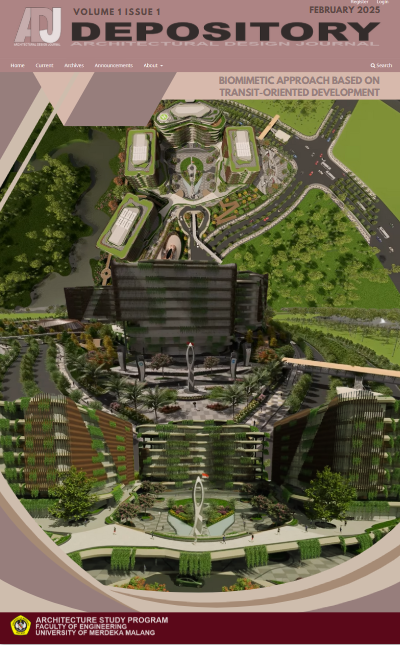THE TOYOMARTO CULTURAL TOURISM PARK Cultural Tourism Park Design Based on Heritage & Healing Retreat with Contextual Architecture Approach
Keywords:
village tourism, water, culture, contextual architectureAbstract
Toyomarto Village has a great potential that can be explored to encourage high and sustainable economic growth from the tourism sector. The geography is very profitable for Toyomarto Village because it is located on the foot of Mount Arjuna so that it has an exotic panorama and still maintains its beauty. In addition to abundant natural resources, Toyomarto Village also has a rich history and culture that dates back to the 14th century, when Toyomarto Village was the civilization area of the Majapahit Kingdom. The background of the naming of Toyomarto Village is derived from the Javanese language which means Toya (Water) A (No) Marta (Dead), interpreted as the water of life, this is related to the water sources that are of very high quality and abundant. Therefore, it is very feasible to design a cultural tourism park that raises the locality of Toyomarto Village using a contextual architecture approach.
Downloads
References
Aleksandrov, K., & Kilimperov, I. (2018). The Role of Destination Management Organizations (DMOS) For Sustainable Rural Tourism in Bulgaria. 18(2), 11–16.
Cahyani, R., Wulandari, L. D., & Antariksa, A. (2015). Simesitas sebagai Kosmologi Ruang Jawa pada Rumah Kolonial di Kampung Bubutan Surabaya (The Symmetricity of Colonial House as Javanese Space Cosmology at Kampung Bubutan Surabaya). Tesa Arsitektur, 12(2), 141. https://doi.org/10.24167/tes.v12i2.393
Chen, S., Sleipness, O., Xu, Y., Park, K., & Christensen, K. (2020). A systematic review of alternative protocols for evaluating non-spatial dimensions of urban parks. Urban Forestry and Urban Greening, 53(July 2019), 126718. https://doi.org/10.1016/j.ufug.2020.126718
Haddad, N. A., & Fakhoury, L. A. (2016). Towards Developing a Sustainable Heritage Tourism and Conservation Action Plan For Irbid’s Historic Core. In International Journal of Architectural Research Naif A. Haddad, Leen A. Fakhoury Archnet-IJAR (Vol. 10).
Hammond, G. P., Iddenden, T., & Wildblood, J. (2017). Environmental and resource burdens associated with an urban community and its surrounding bioregion. Energy Procedia, 143, 481–486. https://doi.org/10.1016/j.egypro.2017.12.714
Hidayat, M. (2011). Strategi Perencanaan Dan Pengembangan Objek Wisata (Studi Kasus Pantai Pangandaran Kabupaten Ciamis Jawa Barat). Tourism and Hospitality Essentials (THE) Journal, I(1), 33–44. file:///C:/Users/AXIOO/Downloads/1879-3318-1-SM (2).pdf
Muka, I. K., & Suardana, I. W. (2024). Innovation of Form and Function of Banyumulek Pottery Craftsmanship in Lombok as Heritage of Traditional Culture. Harmonia: Journal of Arts Research and Education, 24(1), 36–50. https://doi.org/10.15294/harmonia.v24i1.44787
Pipan, A., & Gačnik, A. (2021). Role of Cultural Heritage in the Development of Gastronomy Tourism in the Rural Area: Case of the Vipava Valley. 17, 19–26. https://doi.org/10.18690/AGRICULTURA.17.1-2.19-26.2020
Prima, L., Lussetyowati, T., & Adiyanto, J. (2024). Developing of Village’s Heritage Tourism Planning Through Integrated of Foodscape and Landscape Architecture at Lahat Regency. Sinektika (Surakarta). https://doi.org/10.23917/sinektika.vi.3359
Ramli, S., & Wikantiyoso, R. (2018). Makna Ruang Sebagai Aspek Pelestarian Situs Sumberawan. | 24 | LOCAL WISDOM, 10(1), 24–33.
Song, X., Cheong, K. C., Wang, Q., & Li, Y. (2020). Developmental sustainability through heritage preservation: Two Chinese case studies. Sustainability (Switzerland), 12(9). https://doi.org/10.3390/su12093705
Suharjanto, G. (2011). Membandingkan Istilah Arsitektur Tradisional Versus Arsitektur Vernakular: Studi Kasus Bangunan Minangkabau dan Bangunan Bali. ComTech: Computer, Mathematics and Engineering Applications, 2(2), 592. https://doi.org/10.21512/comtech.v2i2.2808
Titisari, E. (2021). Basic Aspects of Territorial Identity ( Terraphilia ) of Sumberawan Site : Towards Proportional Development of Sumberawan Site. February.
Widisono, A. (2019). The Local Wisdom on Sasak Tribe Sade Hamlet. In Local Wisdom : Jurnal Ilmiah Kajian Kearifan Lokal (Vol. 11, Issue 1, pp. 16–41). Universitas Merdeka Malang. https://doi.org/10.26905/lw.v11i1.2711
Wikantiyoso, R. (2020). Pengembangan Destinasi Wisata Berbasis Masyarakat Menuju Kebertahanan Ekonomi (Community-Based Tourism Destinations Development Towards Economic Resiliency) (1st ed.). Selaras Media.
Wiweka, K. (2021). Tourist Village Multiplier Effect Studies : Small Scale Approach Best Practice of Desa Wisata Nglanggeran ,. International Journal of Management, Innovation & Entrepreneurial Research, 6(2), 139–153.
Zreika, N., Fanzini, D., & Vai, E. (2024). Enriching the “Communities-Cultural Heritage” Relationship to Ensure Effective Culture-Based Urban Development. In Advances in science, technology & innovation (pp. 323–331). https://doi.org/10.1007/978-3-031-49495-6_23
Downloads
Published
How to Cite
Issue
Section
License
Copyright (c) 2025 Lutfan Ridharyanto

This work is licensed under a Creative Commons Attribution-ShareAlike 4.0 International License.
Authors who publish in this journal agree to the following terms:
(1) Copyright of the published articles will be transferred to the journal as the publisher of the manuscripts. Therefore, the author confirms that the journal has managed the copyright.
(2) The publisher of DEPOSITORY: Architectural Design Journal is the Architecture Study Program, Faculty of Engineering, the University of Merdeka Malang.
(3) The copyright follows Creative Commons Attribution–ShareAlike License (CC BY SA): This license allows to Share ” copy and redistribute the material in any medium or format, Adapt” remix, transform, and build upon the material, for any purpose, even commercially.






